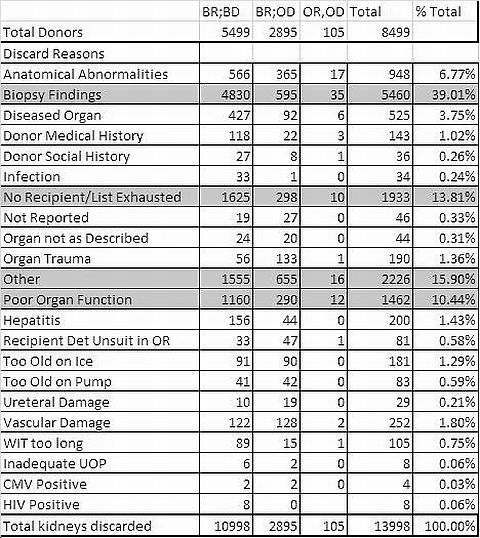Single Versus Dual Kidney Discards: A Detailed Analysis
Transplant Institute, Henry Ford Health System, Detroit, MI
Wayne State University, Detroit, MI
Meeting: 2013 American Transplant Congress
Abstract number: C1246
An ideal kidney allocation system should maximize organ utilization and minimize organ discard rates. It is important to understand the most common reasons why kidneys are discarded in order to make the largest impact in reducing missed opportunities for transplant. We reviewed UNOS data to evaluate for all discard reasons recorded in DonorNet. Data was collected between January 1, 2007 thru March 31, 2012. From this data, we reviewed reasons for discard and also extensively categorized and reviewed discard reasons which were written in under the "other" category. Descriptive statistics were applied.
Overall, 19.75% of recovered kidneys were discarded. 8499 donors gave 16893 kidneys, initially recovered for transplant. 13,998 kidneys were discarded.
In group BR;BD, both kidney were recovered and both were discarded. In group BR;OD, both kidneys were recovered and one was discarded, the other kidney was transplanted. In the third group OR;OD, only one kidney was recovered and subsequently discarded.

Analysis of the BR;BD and BR;OD groups showed that when both kidneys were discarded, reason was more likely to be for Biopsy or No Recipient. When one kidney was discarded, it was more likely to be for Anatomical Abnormalities or Vascular Damage.
In conclusion, we reviewed the most common reasons for kidney discard. Biopsy, Other, List Exhausted and Poor Organ Function remain the most common reasons. The category "Other" was used to communicate multiple reasons for discard as well as reasons that were not available as DonorNet drop down options. The most common write-in reasons for discard were Pump Results, Biopsy and Cancer. Understanding the limitations of communicating discard reasons on DonorNet as well as the most common reasons for discard may reduce missed opportunities for transplant and lower discard rates. In some scenerios, kidney discards rates may vary by side.
To cite this abstract in AMA style:
Malinzak L, Patel A, Kim D, Denny J, Yessayan L, Goggins M, Weitzer M. Single Versus Dual Kidney Discards: A Detailed Analysis [abstract]. Am J Transplant. 2013; 13 (suppl 5). https://atcmeetingabstracts.com/abstract/single-versus-dual-kidney-discards-a-detailed-analysis/. Accessed December 21, 2025.« Back to 2013 American Transplant Congress
